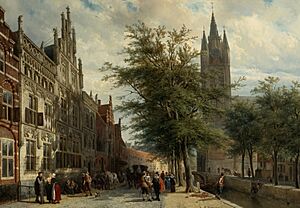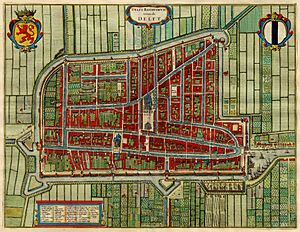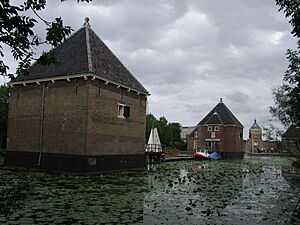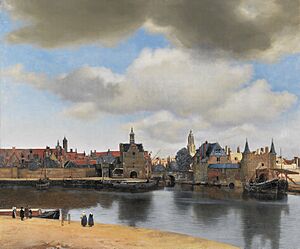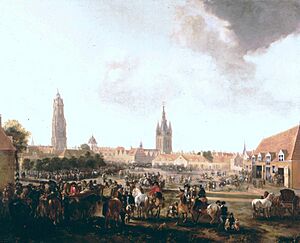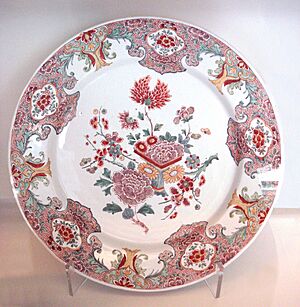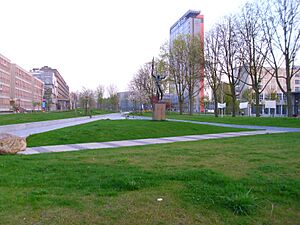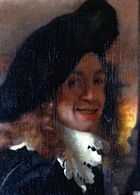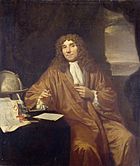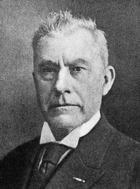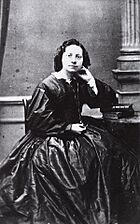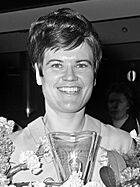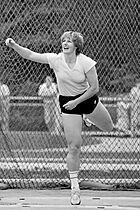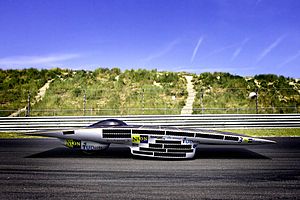Delft facts for kids
Quick facts for kids
Delft
|
|||
|---|---|---|---|
|
City and municipality
|
|||

A view of Delft with the Oude Kerk in the centre
|
|||
|
|||
| Nickname(s):
Prinsenstad (Prince City)
|
|||
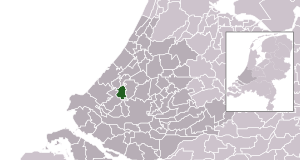
Location in South Holland
|
|||
| Country | Netherlands | ||
| Province | South Holland | ||
| City Hall | Delft City Hall | ||
| Government | |||
| • Body | Municipal council | ||
| Area | |||
| • Total | 24.06 km2 (9.29 sq mi) | ||
| • Land | 22.82 km2 (8.81 sq mi) | ||
| • Water | 1.24 km2 (0.48 sq mi) | ||
| Elevation | 0 m (0 ft) | ||
| Population
(May 2014)
|
|||
| • Total | 99,737 | ||
| • Density | 4,371/km2 (11,320/sq mi) | ||
| Demonyms |
|
||
| Time zone | UTC+1 (CET) | ||
| • Summer (DST) | UTC+2 (CEST) | ||
| Postcodes |
2600–2629
|
||
| Area code | 015 | ||
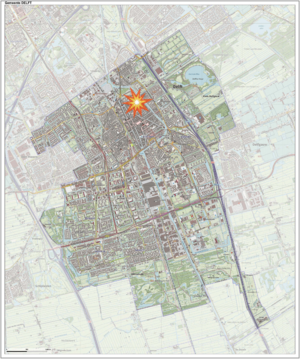
Delft is a historic city in the Netherlands. It is located in the province of South Holland, between the cities of Rotterdam and The Hague. Delft is part of a large urban area called the Randstad.
Delft is a popular place for tourists to visit. It is famous for its connections to the House of Orange-Nassau, the royal family of the Netherlands. The city is also known for its beautiful blue pottery. Famous painter Jan Vermeer lived here, and the Delft University of Technology (TU Delft) is located in the city.
During the Dutch Golden Age, Delft was very important. It is also considered the birthplace of microbiology. This is thanks to the amazing work of scientists like Antonie van Leeuwenhoek and Martinus Beijerinck.
Contents
Delft's Story: A Look at Its History
How Delft Began
The city of Delft started next to a canal called the 'Delf'. This name comes from the word delven, which means to dig. Around 1075, a Count built his manor house where the 'Delf' crossed a river. This helped Delft become an important market town. You can still see how big its central market square is today.
Delft was a small village in the early Middle Ages. But it grew into a city. On April 15, 1246, Count Willem II gave Delft its city charter. This meant it had special rights as a city. Trade and businesses grew strong. In 1389, the Delfshavensche Schie canal was dug. This connected Delft to the sea through the port of Delfshaven.
Until the 17th century, Delft was one of the biggest cities in Holland. For example, in 1400, about 6,500 people lived there. This made it the third largest city. By 1560, Amsterdam was the largest. Delft, Leiden, and Haarlem each had about 14,000 people.
In 1536, a big fire destroyed much of the city.
Delft and the Royal Family
Delft's connection to the House of Orange began in 1572. William of Orange moved into the former Saint-Agatha convent. This building is now called the Prinsenhof. William was leading the Dutch fight against Spanish rule. This fight was known as the Eighty Years' War. Delft was a leading city in Holland. It had strong city walls, making it a good headquarters. In October 1573, Delft successfully fought off a Spanish attack.
In 1581, the Netherlands declared independence. Delft then became the unofficial capital. It was the home of the Prince of Orange.
On July 10, 1584, William was shot and killed. This happened in the Prinsenhof. His family's usual burial place was still held by the Spanish. So, William was buried in the Nieuwe Kerk (New Church) in Delft. This started a tradition. Members of the House of Orange are still buried there today.
Around this time, Delft also became important for printing books.
Art, Science, and Trade
Italian artists who made glazed pottery moved to Delft. They brought a new style of art. The tapestry industry also grew. A famous maker, François Spierincx, moved to the city. In the 17th century, Delft had another golden age. This was because of the Dutch East India Company (VOC). The company opened an office in Delft in 1602. Also, the city became famous for making Delft Blue china.
Many famous artists lived in Delft. These included Leonard Bramer, Carel Fabritius, Pieter de Hoogh, and Johannes Vermeer. Scientists like Reinier de Graaf and Antonie van Leeuwenhoek also gained fame here. They were known for their important research.
The Delft Explosion
A huge explosion happened in Delft on October 12, 1654. It is known as the Delft Thunderclap. A gunpowder storage building blew up. This destroyed a large part of the city. More than a hundred people died, and thousands were hurt.
About 30 tons of gunpowder were stored in barrels. They were in a former convent building. The keeper of the store, Cornelis Soetens, was checking some powder. Then the huge explosion happened. Luckily, many people were away that day. They were visiting a market or a fair.
This explosion is remembered because it killed Carel Fabritius. He was a very promising student of the famous painter Rembrandt. Most of Fabritius's paintings were also destroyed.
The Delft artist Egbert van der Poel painted several pictures. They show the terrible damage to the city. After the explosion, a new gunpowder store was built. It was placed safely outside the city.
Exploring Delft: Famous Sights
Delft's city center has many old, important buildings. Many streets have canals with bridges connecting their banks. This makes Delft a popular place for tourists.
Here are some famous buildings and places to see:
- Oude Kerk (Old Church): Built between 1246 and 1350. Famous people like Johannes Vermeer are buried here.
- Nieuwe Kerk (New Church): Built between 1381 and 1496. It holds the burial place for the Dutch royal family. A very heavy stone covers the vault.
- Prinsenhof: This was once a convent. It is now a museum.
- City Hall: Located on the main market square.
- Oostpoort (Eastern Gate): Built around 1400. It is the only gate left from the old city walls.
- Gemeenlandshuis Delfland: Built in 1505. It has been home to the local water authority since 1645.
- Vermeer Centre: This center is in a rebuilt old guild house. It tells the story of painter Johannes Vermeer.
- Windmill De Roos: A historic windmill built around 1760. It was fixed in 2013 and works again.
- Royal Delft: Also known as De Porceleyne Fles. This is where you can see how Delftware pottery is made.
- Science Center: A fun place for both kids and adults to learn about science.
Delft's Culture and Art
Delft is very famous for its Delft pottery. This pottery was made to look like the Chinese porcelain that was brought to the Netherlands in the 17th century. Delft was a main port for the Dutch East India Company. This helped the city start making its own pottery early on. You can still see this pottery being made at factories like Royal Delft.
The famous painter Johannes Vermeer (1632–1675) was born in Delft. He often painted Delft's streets and homes in his artworks. Other well-known painters also lived and worked in Delft. These included Pieter de Hooch and Carel Fabritius. They were part of the Delft School. This group of painters was known for showing everyday life. They painted homes, church insides, courtyards, and Delft's streets.
Delft also supports modern art and creative businesses. A building called the Bacinol was used by small creative companies. Even though the original building was taken down, the name 'Bacinol' and the businesses moved to another spot in the city.
Learning in Delft: Education
Delft University of Technology (TU Delft) is one of the top technology universities in the Netherlands. It started in 1842 as an academy for civil engineering. This was set up by King William II. In 2022, over 27,000 students were studying there.
The UNESCO-IHE Institute for Water Education is also in Delft. It offers advanced education for people from developing countries. This institute uses Delft's long history in water management and hydraulic engineering.
Other universities also have buildings on the TU Delft campus. These include The Hague University of Applied Sciences and Inholland University of Applied Sciences. They offer many different study programs.
Delft's Economy: How the City Works
Delft's economy relies on several key areas:
- Education: The Delft University of Technology is a major part of this. In 2017, it had over 21,000 students and nearly 5,000 staff members.
- Scientific Research: Many research groups are in Delft. These include "TNO" (Netherlands Organisation for Applied Scientific Research) and the UNESCO-IHE Institute for Water Education.
- Tourism: About one million visitors come to Delft each year.
- Industry: Companies like DSM Gist Services BV and De Koninklijke Porceleyne Fles (Royal Delft pottery) are here.
- Retail: Large stores like IKEA and Makro are located in Delft.
Nature and Fun in Delft
East of Delft, there is a large nature and recreation area. It is called the "Delftse Hout" ("Delft Wood"). This area has paths for biking, horse-riding, and walking. It also has a big lake where you can swim and windsurf. There are beaches, a restaurant, and even a camping ground.
Inside the city, there are several smaller parks. These include "Nieuwe Plantage" and "Agnetapark". The Botanical Garden of the TU Delft is also a nice place to visit.
Notable People from Delft
Many important people were born in Delft or lived there.
- Artists:
* Jacob Willemsz Delff the Elder (c. 1550–1601), portrait painter. * Johannes Vermeer (1632–1675), famous painter of everyday scenes. * Betsy Perk (1833–1906), author and pioneer for women's rights. * Marly van der Velden (born 1988), actress.
- Thinkers and Leaders:
* Hugo Grotius (1583–1645), a very important lawyer and thinker. He helped create the idea of international law. * Frederick Henry, Prince of Orange (1584–1647), a prince and leader of Holland. * Marja van Bijsterveldt (born 1961), the current Mayor of Delft.
- Scientists and Business People:
* Antonie van Leeuwenhoek (1632–1723), known as the "father of microbiology". He developed the microscope. * Martinus Beijerinck (1851–1931), a microbiologist who discovered viruses. * Boyan Slat (born 1994), an inventor and entrepreneur. He is known for his work with The Ocean Cleanup.
- Sports Stars:
* Stien Kaiser (born 1938), a speed skater who won Olympic medals. * Ria Stalman (born 1951), a discus thrower who won an Olympic gold medal. * Michaëlla Krajicek (born 1989), a tennis player. * Arantxa Rus (born 1990), a tennis player.
Cool Projects and Sports
- Nuna is a series of solar-powered cars. Students from the Delft University of Technology build them. These cars have won the World solar challenge in Australia seven times!
- The "Superbus" project was led by Dutch astronaut Wubbo Ockels. It aimed to create super-fast buses that could travel up to 250 km/h.
- Students from Delft's rowing clubs have won many international awards. This includes Olympic medals.
- The Formula Student Team Delft is a student racing team. They have won the Formula Student competition in Germany three times in a row.
- The Human Power Team Delft & Amsterdam has won The World Human Powered Speed Challenge four times. They set a world record in 2013, reaching 133.78 kilometers per hour on a special bicycle.
Getting Around Delft: Transport
- Delft railway station: The main train station, located in a new building since 2015.
- Delft Campus railway station: Another train station serving the university area.
Trains run very often between Delft and nearby cities like Rotterdam and The Hague. There are also many bus routes. Trams frequently travel between Delft and The Hague.
Parking in Delft's city center can be quite expensive. In 2018, it was the most expensive on-street parking area in the Netherlands.
Images for kids
See also
 In Spanish: Delft para niños
In Spanish: Delft para niños






